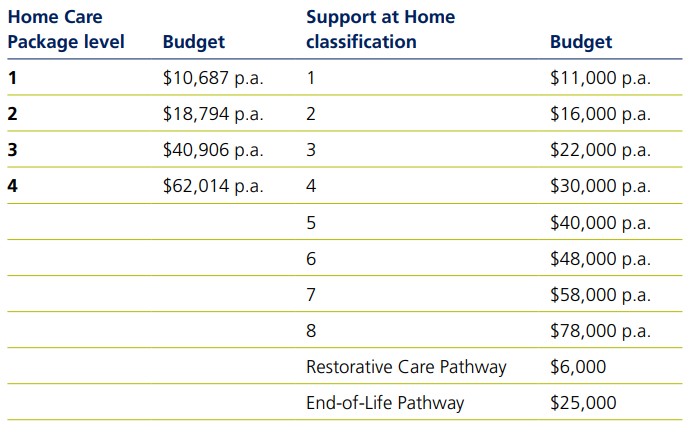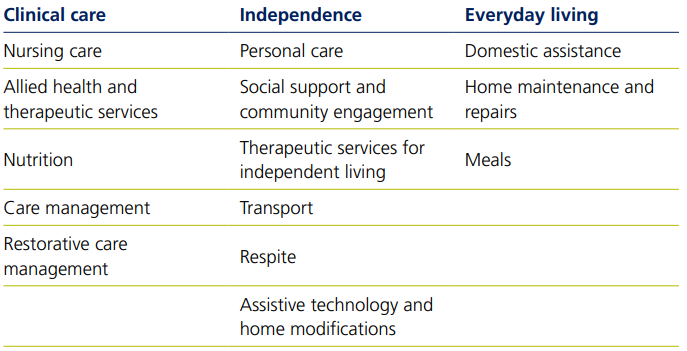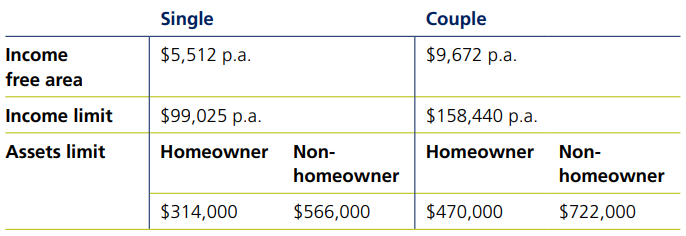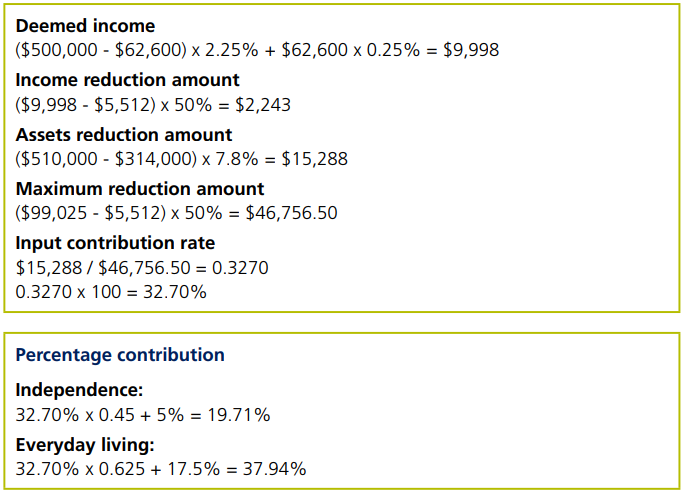Home Care reforms from 1 July 2025

Home Care reforms from 1 July 2025
Download the article.
As part of the aged care reforms, the Support at Home Program will replace Home Care Packages and Short-term Restorative Care from 1 July 2025. The Commonwealth Home Support Program will continue until 1 July 2027 when it will transition to the Support at Home Program.
In this month’s article we will look at the changes to the funding provided for home care and the fees payable from 1 July 2025. Where available, we have used current thresholds and where not available, we have used thresholds quoted in Government material.
Funding provided by the Support at Home Program
The four levels of home care packages will be replaced by eight ongoing classifications and two short term classifications (Restorative Care Pathway and End of Life Pathway) from 1 July 2025. As with home care packages, the Support at Home budget will increase as the classification increases1.

The Support at Home budget will be paid quarterly and held on behalf of the recipient in an account managed by Services Australia. Home care providers will invoice Services Australia to be paid for home care services after they have been provided.
Support at Home recipients will be able to save up to $1,000 or 10% of their quarterly budget (whichever is greater) for the next quarter. Recipients will have 10% of their quarterly budget allocated to a funding pool for care management services.
The Restorative Care Pathway will replace the Short-Term Restorative Care Program from 1 July 2025. The Restorative Care Pathway will provide allied health services to regain function and allow individuals to live independently at home.
The Restorative Care Pathway will provide $6,000 for 12 weeks which may be extended to 16 weeks if additional time is required. This amount can be accessed twice within a 12-month period however, it cannot be accessed in consecutive quarters.
The End-of-Life Pathway will provide funding for individuals with less than three months to live who wish to stay at home. Existing Support at Home recipients can access the End-of-Life Pathway via a high priority support plan review. Individuals who are not existing recipients will be referred for a high priority assessment to determine eligibility for the End-of-Life Pathway.
The End-of-Life Pathway will provide $25,000 for up to 12 weeks and will work in conjunction with other specialist palliative care services. This amount can only be accessed once however, recipients who live longer than 12 weeks will transfer to the Support at Home Program.
Defined service list
The Government will introduce a defined service list as part of the Support at Home Program from 1 July 2025. The service list will have 3 categories (clinical care, independence and everyday living) with their own service types. Home care providers will set prices for home care services from 1 July 2025 however, the Government will set price caps from 1 July 2026.

For the list of services that can be accessed through the Support at Home Program, see the Support at Home Service List on the Department of Health and Aged Care website Support at Home service list | Australian Government Department of Health
and Aged Care.
Participant contribution towards the Support at Home Program
The basic daily fee and income-tested care fee will be replaced by a participant contribution for home care services from 1 July 2025. The participant contribution will be a percentage of the price for home care services received. The percentage will depend on the type of service and pensioner status of the recipient. The participant contribution will have a lifetime cap of $130,000 (indexed).

Independence and everyday living services for part pensioners and Commonwealth Seniors Health Card holders will be means-tested as follows2:
Step 1: Work out the income reduction amount
(Assessable income - income free area) x 50%
Step 2: Work out the assets reduction amount
(Assessable assets - assets limit) x 7.8%
Step 3: Work out the maximum reduction amount
(Income limit - income free area) x 50%
Step 4: Work out the input contribution rate
(Greater of Step 1 and 2 / Step 3) x 100
Step 5: Work out the percentage contribution
Independence (Step 4 x 0.45 + 5%)
Everyday living (Step 4 x 0.625 + 17.5%)

Assessable income and assets for the Support at Home Program will be the same as that assessed for Centrelink purposes. Where the Support at Home recipient does not disclose their means, they will be assessed as a self-funded retiree.
Example
Giovanni is single, a homeowner and has been approved for home care. He has $500,000 in term deposits and $10,000 of personal contents. He currently receives a part Age Pension of $14,856 p.a. What is the calculation of his participant contribution?

Grandfathering existing home care recipients
Grandfathering arrangements for existing home care recipients will be separated into funding and fees with the relevant dates being 30 June 2025 and 12 September 2024 respectively.
Existing home care package recipients on 30 June 2025 will receive the same funding from 1 July 2025. If these recipients require higher funding they will need to be reassessed under the Support at Home program at a higher funding classification (see above).
Existing home care package recipients on 12 September 2024 who do not currently pay an income-tested care fee will continue to pay no fees under the Support at Home Program. Existing recipients on 12 September 2024 who currently pay an income-tested care fee will pay the same or less than their current fees under transition arrangements.
For more information about the Support at Home transition arrangements, see the Support at Home Program handbook on the Department of Health and Aged Care website Support at Home program handbook | Australian Government Department of Health and Aged Care.
Grandfathered home care package recipients who move to residential care from 1 July 2025 will also be grandfathered under the current fee structure for residential care unless they opt into the new structure. The new accommodation structure for residential care, will still apply to grandfathered recipients as this is an agreement between the resident and the residential care provider.
These grandfathering arrangements for fees will also apply to individuals who were in the National Priority System or assessed as eligible for a home care package on 12 September 2024.
Assistive Technologies and Home Modifications Scheme
The Government will introduce an Assistive Technologies and Home Modification (AT-HM) Scheme from 1 July 2025. The AT-HM Scheme will provide funding for individuals to access products, equipment and home modifications to live independently at home.
There will be 3 funding tiers for assistive technology and 3 funding tiers for home modifications with set time periods in which the funding must be spent3. The high funding tier time period for home modifications may be extended to 24 months to complete complex modifications.

AT-HM recipients will have to pay the participant contribution and meet any additional costs above the funding cap. The high funding tier cap for assistive technology may exceed $15,000 with a valid prescription from a health professional.
For the list of products, equipment and home modifications that can be accessed through the AT-HM Scheme, see the AT-HM List on the Department of Health and Aged Care website Assistive Technology and Home Modifications List (AT-HM List) | Australian Government Department of Health and Aged Care.
1 Budgets published on the Department of Health and Aged Care website as at 5 February 2025.
2 Centrelink thresholds as at 1 January 2025.
3 Funding caps published on the Department of Health and Aged Care website as at 5 February 2025.
Challenger 30 January 2025
UPDATE: On 4 June 2025, the Australian Government announced its intention to defer the commencement of the new Aged Care Act to 1 November 2025 and has recommended that the Governor-General formally proclaim this revised start date. While the details and examples provided in this article remain accurate for the legislation as enacted, advisers should be aware that the effective date is now proposed as 1 November 2025.
Challenger Technical will provide further updates once the formal proclamation is issued. In the meantime, please consider this timing change when preparing aged care strategies for clients planning to enter care in the second half of 2025.
Related content
Stay informed
Sign up to our free monthly adviser newsletter, Tech news containing the latest technical articles, economic updates, retirement insights, product news and events.
